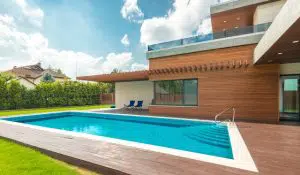Swimming Pool Shapes: How to Choose?
December 20, 2021
The shape of your inground pool will determine how much space you have for activities, what the maintenance requirements are and what is available for the overall design of your yard and surroundings. We’ll discuss the most popular shapes in this article to help you choose which one is best suited to your needs.
Rectangular Pools
Of all the different pool shapes available, rectangular pools are the most popular shape for swimming pools in the United States. Rectangles offer a large amount of space and tend to have a lot of options in terms of design since they are such a popular shape. If your yard is relatively open, these pools can usually be built into an existing yard without too much trouble regardless of the dimensions.

However, rectangular pools don’t provide options for working around existing structures. If you have trees or other immovable objects, you won’t be able to negotiate around them with a rectangular pool. Some pool builders may be able to customize a rectangular pool by “taking off a corner” but it’ll add to what are usually already high costs.
L-Shaped Pools
L-shaped pools are another popular shape and offer a lot of room for activities. The longer side can be great for lap swimming, while the shorter side is usually used as an entry or diving area. L-shaped pools are extremely popular because they offer you a lot of flexibility as far as how it fits into your yard, but also in terms of how you use the pool itself.
If you’d like to have a diving board or slide, you’ll need a deep end of your pool to meet the depth requirements for each. Having an L-shaped pool allows you to use one leg as the deep end while clearly delineating it from your shallow end which can be used for younger children or the pool’s access point with built-in stairs.
Kidney-Shaped Pools
Kidney-shaped pools are a sleek and contemporary shape that offers modern appeal to any backyard, small or large. A kidney-shaped pool has rounded edges with an indention along the long axis of the pool. The kidney shape allows for some flexibility in terms of where you can place the pool and allows owners to have some fun with the design with multiple options for where to add access points. Meanwhile, the indention creates a natural marker if you want to add a deep end, and many kidney-shaped pools have one wider end that can be made into a larger deep or shallow end, whichever you prefer.
Freeform Pools
Freeform or irregular-shaped pools are a great choice for those who want something unique. There aren’t any construction limitations on this type of pool, so you can pretty much design it however you like. For example, some homeowners might choose to build their free forms in the shape of an animal’s body or incorporate other fun elements into its design that give it character and reflect the owner’s personality.
Freeform pools have almost limitless options, but that can also come with a near-limitless price tag. You’ll also need to consider how a unique shape can impact the pool’s pumps, filters, chemical use, etc. You’ll want to consult your pool builder to get a better idea of how a unique swimming pool design can impact the long-term costs for chemicals and maintenance.
Oval Pools
Oval pools are another geometric shape (square, rectangle, circle, etc.) that is growing in popularity – these designs are essentially just rectangles with rounded ends. Elliptical options offer lots of space making them great for families who want to keep their kids entertained all day long without feeling like everyone is on top of each other. They can be set up with straight or curved sides and different depths, but if you’re going the extra mile, make sure your pool’s design falls within standard measurements so it requires less maintenance.
If you enjoy lap swimming, oval pools can be a great choice.
Square Pools
Square pools are rarer than most of the other shapes listed here but are often suitable for those who want to maximize yard space by using a smaller shape. However, this pool style is not as popular because it doesn’t offer the same space or flexibility in design as oval and kidney shapes. Square pools can offer an extremely contemporary look for small backyards, though, and make an excellent centerpiece for an entertaining space in a smaller yard.
These are the most common pool shapes and designs. With so many shapes to choose from, how do you know which one’s right for your yard? The best way is to consider what you’ll want most out of your pool and then find a shape that will accommodate those needs while staying within your budget.
It’s also important to take a close look at the size, shape, and existing structures in your yard as well as the surrounding landscaping. Many people who have smaller yards often opt for kidney-shaped pools because they offer the same amount of area as regular rectangle or L-Shaped pools but without having to account for the extra room taken up by square corners at each end. Again, the main benefit to this type of shape is that it takes up less yard area, saving money on excavation costs and giving you more flexibility with the surrounding landscaping. Freeform pools are also a great choice for many because you get the most pool surface area concerning your available backyard space while maintaining a unique look.
Once you decide on the optimal size and shape for your pool talk to your contractor about adding some top-quality American-made accessories from Global Pool Products. Our pool handrails, ladders, slides, and lifts can make your pool more accessible and more fun for you and your guests.
